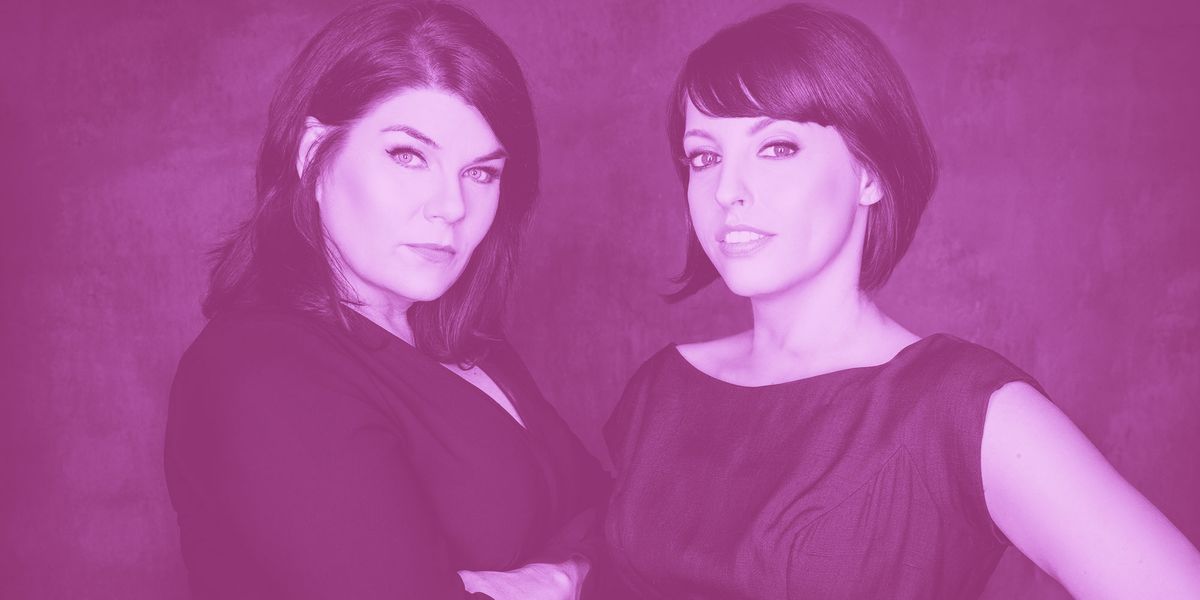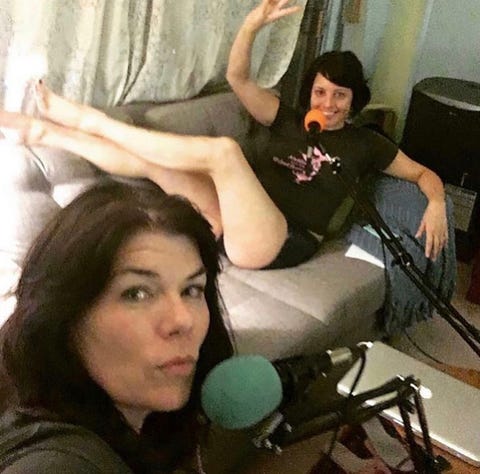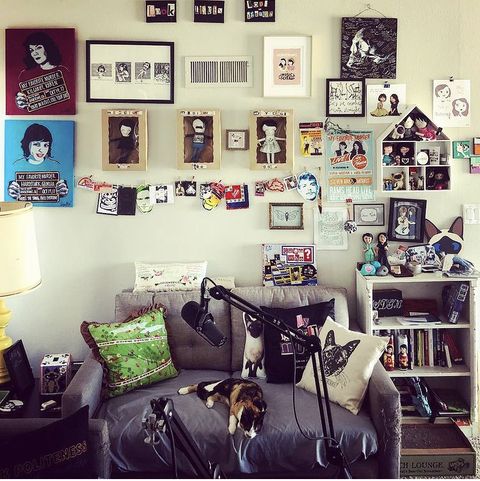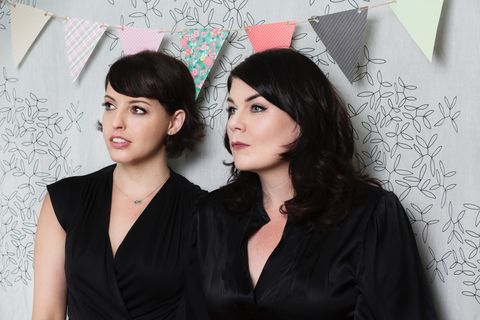I have a confession: my self-care ritual of choice is listening to two women tell each other horrifying stories about murder. With all due respect to hot baths, cookie dough, and yoga, nothing has been more consistently comforting to me over the past hellscape of a year than the voices of Karen Kilgariff and Georiga Hardstark, who co-created and co-host the irreverent but heartfelt true-crime podcast My Favorite Murder. And I’m far from alone.
Looking back on the past few years of pop culture, you’d be hard-pressed to find two genres that have exploded more dramatically than true crime and podcasting. My Favorite Murder sits at the intersection of both, and so in retrospect, it’s no surprise that the show is a blockbuster, breaking download records, regularly topping podcast charts, and spawning a dedicated hardcore fanbase of “Murderinos.” In podcast terms, it doesn’t get bigger than MFM. But five years ago, when Karen Kilgariff and Georgia Hardstark sat down in a tiny Hollywood apartment to record themselves telling each other their favorite stories about murder, they weren’t thinking big. They were mostly just hoping they weren’t making a huge mistake.
“We’re gonna be vilified for this podcast,” Hardstark groans in their January 2016 debut. The duo’s trepidation is clear: There’s nervous laughter, self-deprecating jokes about being creeps, and a general sense that the show may not be everybody’s cup of tea. “This is the end of our careers as we know them,” Kilgariff deadpans. That part turned out to be prescient.
Early in the episode, the two hosts recount meeting at a party and bonding over their mutual fascination with the morbid, while everyone around them blanched and backed away. “Tell me everything so I can avoid it!” Hardstark cries as Kilfgariff describes a grisly scene, encapsulating the anxious thought process that bonds the hosts and their listeners. These are women who spend a lot of time thinking about the very worst things that can happen, often in a misguided attempt to feel safe. I am also this type of woman, which explains why I’ve listened to every single episode of My Favorite Murder at least once.
Five years on from the show’s debut, true crime has become truly mainstream. If Kilgariff and Hardstark met at that same party today and started talking about murder, they likely wouldn’t be the only ones joining in. But back in 2016, MFM represented a safe space for legions of women who felt ashamed of their obsession.
“That first wave was just a bunch of people going, ‘Oh my God, me too! I thought I was weird, I thought I was morbid, I thought I was a freak,’” Kilgariff tells me moments after I jump on a three-way Zoom call with her and Hardstark. Despite the inherent stiltedness of a virtual face-to-face, the duo’s rapport comes through clearly, as does their fondness for the “incredible, responsible badasses” who make up their fanbase, to quote Hardstark. “We’re not just talking to the void—we know exactly who we’re talking to.”
So, who exactly is that? “It’s not like there’s a certain look,” Kilgariff muses. “We have the witchy librarians, and we have the blonde soccer moms, and we have the young college students, and we have grandmas that have gone to every famous trial and sat in the gallery. But the vibe of the person is the same. It’s recognizable when they come up to us. They talk about these stories and these crimes with a kind of passion that I think usually gets written about, and talked about: like it’s rubbernecking, like it’s salacious, like it’s negative. Actually, I think it’s the opposite.”
It’s the opposite, in part, because Kilgariff and Hardstark’s driving force is empathy. Though true-crime audiences skew female, the actual storytelling has been historically male-dominated. “It’s a relatively new thing that women are the ones having the conversation—we usually listen to men tell us how it went,” Kilgariff notes. Her true crime obsession started in the ’90s, when the tone of the conversation was, as she puts it, “a little wonky. It was all about Ted Bundy being so fascinating and ‘isn’t Richard Ramirez hot’ and people buying John Wayne Gacy’s artwork. And even back then, yeah, I read all these books because I was interested in it, but I think owning a painting by John Wayne Gacy would be the most creepy, haunted fucking thing you could do. Why would you want to look at that? That’s so bad for you!”
My Favorite Murder, by contrast, centers the victims of crime—not the perpetrators. Many of the most beloved episodes focus on survivor stories, while others add dimension to the lives of victims, exploring the layers of trauma a violent crime leaves on individuals, families, and whole communities. It’s an approach shared by Michelle McNamara’s extraordinary posthumous book I’ll Be Gone In The Dark, which is both a gripping chronicle of the Golden State Killer’s spree and a searing memoir about the psychological toll of crime obsession. McNamara, whose work is referenced often on MFM, eloquently describes the strange feeling of being truly, painfully invested in a long-unsolved case to which she had no personal connection. Far from rubbernecking, Kilgariff describes this as “a holding of a terrible thing”—making space within yourself for the experience of the victims and the horror they endured.
“There’s an empathy, because our whole lives, we’ve been worried about these things, and really aware of how vulnerable we are,” Hardstark continues. “The show feels like a way we’ve all come together as this group to acknowledge that with each other, and not be ashamed of what other people would call rubbernecking. It’s more of an acknowledgement that other people have these life experiences that we can only fathom, but we fathom them with our insomnia and our anxiety.”
Looking back on the past five years of MFM, there’s one moment that stands out in my memory. In the show’s 33rd episode, Kilgariff tells the story of Jennifer Morey, a young woman who lived alone and was raped at knifepoint in her bed by a man who turned out to be a security guard at her apartment complex. After her attacker slashed her throat, Morey narrowly escaped into the bathroom, and survived thanks in large part to a shrewd 911 operator.
I confess to Kilgariff and Hardstark that I’m about to move into my own apartment after years with a roommate, and I’ve been thinking a lot about Morey’s story. She chose her building specifically because it seemed so safe—it was gated and employed 24-hour security staff. That her attacker was part of that staff is a nightmarish twist, and a reminder that women’s fears about violent crime are not irrational or inappropriate.
Shortly after the episode aired in 2016, Morey emailed the show. “My immediate feeling was horror,” Kilgariff recalls. “Before I knew anything about what she had written, I was just like ‘Honestly, maybe we shouldn’t do this anymore.’ If she was upset, if there was anything bad in that email, that was kind of it for me.” But Morey was not upset. She felt affirmed by the way Kilgariff and Hardstark had discussed her story.
A year later, Morey came to a My Favorite Murder live show and received a hero’s welcome. “It was like the Beatles when she walked on that stage,” Kilgariff recalls, visibly emotional at the memory. “That audience was full of people who knew who she was and what she’d been through, and were just so thrilled to be able to show her how much they cared.” Hardstark, too, is tearing up. “I’m on new medication that allows me to cry,” she says with glee, “So now I’m like oh, fuck, this is what it feels like to have emotions again!’”
This offhand reference to medication is another hallmark of what sets Kilgariff and Hardstark’s rapport apart from your standard “armchair quarterback” crime podcast. The Venn diagram between anxiety and true crime obsession is pretty much a circle, and the pair acknowledge that fact in every episode of the show, blending their murder stories with candid conversations about mental illness, addiction, and trauma. Two years ago, when fans began sharing pictures of their meds under the hashtag #MyFavoriteMeds in a bid to combat stigma, Hardstark joined in. And both have spoken openly about going to therapy—not just as individuals, but together as business partners, to address tensions that arose as MFM began to take off.
“How do you improve a relationship that millions of people are staring at?” Kilgariff says. “It was this very difficult time where we had the podcast, we were touring, we’d agreed to write a book, and we were starting this network. So we couldn’t have had more work, we couldn’t have been talking to each other more, we could not have been having more conversations about ‘do you agree with me or not’ all day every day. It was a lot.”
Watching the duo interact, it’s hard to imagine any tension. Even via Zoom, their affection for each other is tangible, as is their simpatico relationship. “What am I trying to say, Karen?” Hardstark murmurs at one point early in our conversation, doubting herself mid-flow, and Kilgariff steps in to continue the thought. It’s the kind of beyond-words bond that comes with spending years creating together, but it’s also not a bond that has always come easy. “Georgia and I are very similar in our anxieties and our control issues,” Kilgariff explains, “and we’re very similar in our confidence that we have it all figured out. Of course, that is a fucking terrible combination, but that combination and the chemistry of it is the reason this show is popular.” The first few therapy sessions were tough, both admit, but they knew they had the foundations of something great. “We gave ourselves over to the fact that we weren’t going to quit, we were just going to try to figure it out as we went. We were going to disagree, there were going to be issues, it’s not a party all the time. But we were in a position to really build something amazing.”
What they’ve built is the Exactly Right network, “our baby that’s really growing up into a toddler that’s in the 95th percentile,” Kilgariff quips. Launched in the summer of 2018, the network now has 11 shows encompassing many genres: there are more true-crime series, of course, but also the cat-themed Purrcast, the disease-obsessed This Podcast Will Kill You, and the weird news show Bananas (highly recommended as an antidote to literally all other news). No matter the subject, all the network’s shows share MFM’s essential ingredients: irreverent wit, charismatic hosts, and unexpected angles on familiar subjects.
“We wanted to take our podcast clout, and add a bunch of people we think are talented and amazing, and build them up along with us,” Kilgariff says. “It’s such a joy because it can be very isolating to have this kind of success,” Hardstark adds, “so to be able to pull in the people we love and admire and believe in, and get them a little of this as well, it’s so rewarding. It makes it all worth it.”
Inevitably for a show of its size—and for a show that is often categorized as both “true crime” and “comedy”—MFM has also faced its fair share of backlash. Kilgariff and Hardstark have been receptive to criticism, and their approach to discussing subjects like systemic racism, sex work, and police misconduct has evolved substantially over the years. “When people do say to us, ‘You should try it this way,’ or ‘I would refrain from this,’ it’s always constructive and they tell us because they know that we’ll take it to heart, and make those changes, which we’re so happy to do,” Hardstark says earnestly.
But then there are the bad faith critiques from people who have either not heard the show, or choose to willfully misread its colloquial tone as disrespect. “We spend a lot of time talking about what outsiders think, and it just kind of doesn’t matter,” Kilgariff shrugs. “Even though we might be laughing and joking with each other about how we just mispronounced a word, or how we don’t know where most major towns in America are, that doesn’t mean that we’re looking at these stories as funny or as fodder. It just doesn’t. And why explain it when all the people that are in—and that’s kind of a lot of people—get it?”
As my conversation with Kilgariff and Hardstark winds down, we circle back around to talking about anxiety, a subject that’s never far from my mind. One of the cognitive distortions that drives my anxiety is catastrophizing—imagining the very worst that could happen, or, say, spending hours Googling stories about crimes and criminals that represent the very worst that could happen. That Venn diagram is a circle for a reason. “I’ve always felt that the more I learn, and the more I read about it, and the more I watch, I’ll be able to be prepared, which I know is a hundred percent not true,” Hardstark reflects. “That habit has kept me up nights since I was a child. But the way to have more agency over it is to tell these stories from the place of the person that we identify with the most, which is the victim. It’s empowering them.”
This content is created and maintained by a third party, and imported onto this page to help users provide their email addresses. You may be able to find more information about this and similar content at piano.io




